Accidents can happen anytime but are more likely when you are camping. This is why you always need to have a complete first aid kit with you when camping. I’ve made a printable camping first aid checklist with everything you might need.
Download the checklist here (PDF). Or keep reading to see the checklist and what the items are used for.
Note this checklist is for car camping. When I am going backpacking and can’t carry all of these items, I bring a paired down version. See my ultralight backpacking first aid kit checklist here.
Most Common Camping Injuries
Camping isn’t dangerous per se, but you are doing a lot of tasks which you normally don’t do. Like chopping wood, or stoking a fire, or navigating tough terrain.
These injuries include:
- Small cuts and scrapes
- Burns
- Sprained ankles
- Major wounds, such as from serious falls
- Broken bones
- Overexertion
- Hypothermia
- Insect bites
- Plant-based – Poison ivy, stinging nettles, plant
Take a first aid course!
Having a camping first aid kit won’t do you much good if you don’t know how to use the items within the kit. I strongly suggest you take a wilderness first aid course so you know what to do if something bad occurs. Don’t rely on the campground staff or park rangers to be there to help!
If you can’t sign up for a course now, then I suggest getting this book. It goes over basic and advanced first aid in wilderness situations. You’ll learn skills like how to stop bleeding, treat hypothermia, splint a broken bone, and more.
Don’t Forget about a First Aid Kit for Day Hikes
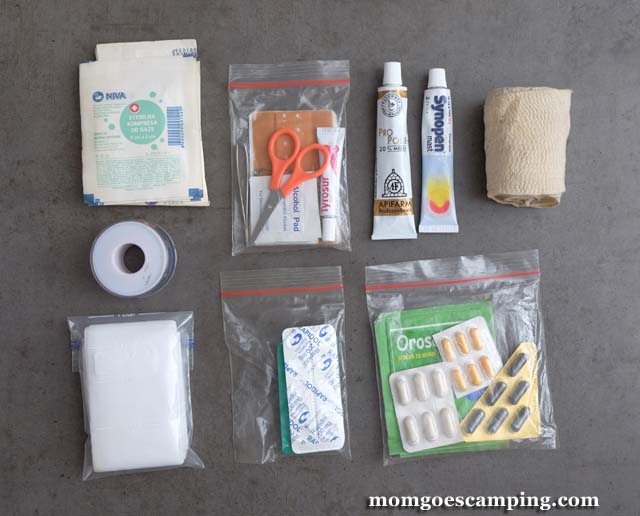
Planning on going hiking during your camping trip? Please bring a first aid kit with you!
Day hikers often set out with minimal supplies because “it’s only going to be a short hike.” Then something goes wrong and they find themselves completely unprepared. The same goes for any other day activities like mountain biking or canoeing: bring a first aid kit!
It’s probably not feasible to bring your entire first aid kit with you on a hike. Instead, I bring a minimal version of the first aid kit. It’s actually the same kit I take backpacking. I keep it packed and stored with my camping gear. This saves me the hassle of packing it before each trip.
- Get the mini version of the first aid kit here.
- Also please read this post on What to Take with You Hiking. It includes must-have items like a headlamp, rain jacket, lighter, and first aid kit.
Camping First Aid Kit Checklist
As mentioned before, you should have a first aid kit in your car anyway. This kit should contain everything you need for camping, as well as car accidents. Keep it stocked and you won’t have to pack a first aid kit each time you go camping; it will always be ready.
Here’s what you need to make sure is in your kit. I’ve broken the items down by what they are used for.
Don’t want to build your own first aid kit? Here are the best camping first aid kits you can buy.
Trauma Items (Bleeding Wounds and Burns)
- Adhesive bandages in various sizes (Band-Aids): These are what you’ll use for minor scrapes and cuts.
- Moleskin: Used for blisters.
- Hemostatic pads/dressings (such as QuikClot): If a major injury occurs, use these to apply pressure to the wound and stop bleeding. The hemostatic agent causes blood to clot.
- Sterile heavy gauze: This is used to bandage larger wounds. It can be cut to size and is held in place with medical tape or a roller bandage.
- Gauze roller bandages: These can be used to bandage injuries in difficult locations, to hold bandages in place, to apply pressure to a wound, or to tie a splint in place.
- Butterfly bandages (or Zip stitch): These are used for narrow, deep cuts like knife wounds. They hold skin on both sides of the wound closed until it can be sutured.
- Medical tape: In addition to holding bandages in place, it can be used for patching holes in tents, fixing broken tent poles, and much more.
- Tourniquet: This can literally save a life. Read how to use a tourniquet here.
Wound Care and Cleaning
- Sterile irrigation solution
- Irrigation syringe
- Antiseptic wipes
- Sterile cotton swabs
- Antiseptic ointment: Always apply this over wounds. It prevents infection and stops the bandage from sticking to the wound.
- Burn gel: Aloe vera gel is good for this. I use a beeswax-based balm which can also be applied to sunburn and my lips.
Bone and Ligament Injuries
- Triangle bandage: This can be used for making a sling, tying a splint in place, making an eye patch, bandaging a head injury, and much ore.
- Ace bandage: For sprains
- Hot/cold pack
- Splints (C-splint or Sam splint recommended): Yes, you can improvise a splint but these are much more effective. Don’t plan to improvise!
Medications, Ointments and Creams
- Acetaminophen
- NSAID pain killers (aspirin, ibuprofen, naproxen)
- EpiPen for known allergies
- Anti-diarrheal medicine: Note you shouldn’t use these if you have bloody stools.
- Probiotics: For upset stomach
- Activated charcoal: Good for food poisoning, upset stomach, and gas
- Emetics for inducing vomiting: In case someone consumes a poisonous plant
- Electrolytes: For treating dehydration
- Itch/sting ointments such as hydrocortisone
- Anti-fungal creams
- Antacids
- Cough/cold/flu medicines
- Insect repellent
- Sunscreen
- Lip balm
- Personal medications
Other Items
- Packet of honey: For treating hypothermia or low blood sugar
- Tweezers: Choose needle-nose tweezers for removing debris from wounds as well as removing ticks.
- Safety pins: For removing splinters
- Small scissors
- Medical shears
- CPR barrier
- Thermometer
- Magnifying glass
- Disposable gloves
- Antibacterial hand gel
- Emergency Mylar blanket
- Tooth pain gel
- Temporary tooth filling
- Nail clippers: I used to forget these and inevitably get annoying hangnails while camping. Now I keep them in my first aid kit.
- First aid field guide
Baby and Children First Aid Items
- Children’s versions of medicines: At the very least, bring ibuprofen in case your child gets a fever
- Nose aspirator
- Measuring syringe
- Diaper rash cream
What’s in your first aid kit for camping? Did I miss anything? Let us know in the comments.
Featured image credit:”camping first aid” (CC BY 2.0) by aronbaker2


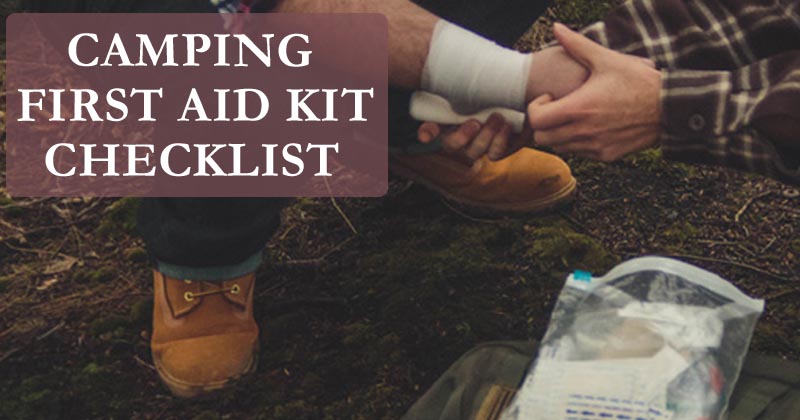
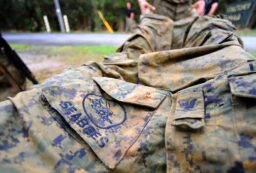
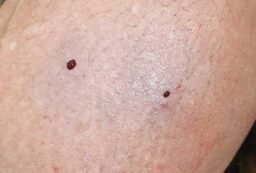
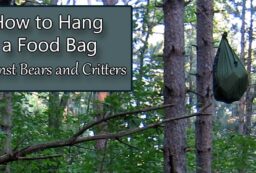







Post your comments